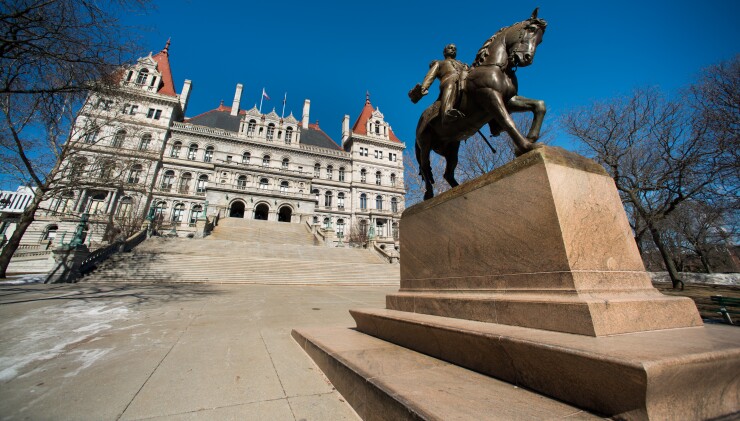New York’s new state budget provides flexibility to deal with near-term revenue hits from COVID-19, but it has little bandwidth to withstand a deep recession.
The $177 billion fiscal 2021

Through Tuesday, COVID-19 had killed more than 6,200 people in the state, according to the state Department of Health.
The state is vulnerable to a severe economic downturn, analysts say, because of inadequate reserves to address looming tax revenue losses.
A $428 million deposit in New York’s Rainy Day Fund brought the state’s total reserves to $2.5 billion. No other Rainy Day deposits are scheduled in the 2021 fiscal year.
In addition to the rainy day fund, New York State also established a new reserve account for economic uncertainty that was just $900 million entering the 2021 fiscal year on April 1. The state also has around $1.1 billion from past financial monetary settlements and designated a $500 million debt management account, according to Division of Budget. Total reserves number about $5 billion.
“It’s a very small amount of money in the context of multi-year negative financial impacts the state us facing from the recession,” said David Friedfel, director of state studies for the independent Citizen Budget Commission. “In light of the revenue losses, those reserves are relatively small.”
The CBC has advocated the past few years for New York to bolster its reserve position through increased Rainy Day Fund deposits. The state had an opportunity to sure up reserves when it received around $12 billion in financial settlements from 2015 to 2018, but did not use any of it for rainy day funds.
Friedfel noted that New York’s current reserves are small relative to the likely revenue losses that would occur during a recession. A 2018 CBC analysis showed that year over year tax revenue losses experienced in the 2002-2003 recession and the Great Recession of 2008 would translate into losses between $9.2 billion and $12.0 billion in the first two years of another economic downturn.
“The state definitely missed an opportunity to not use more of the bank settlement funds for reserves,” Friedfel said. “It can be politically challenging because of calls for increased spending from different groups, but if you have more in reserves you don’t have to cut as deep in a recession.”
E.J. McMahon, founder and research director for the conservative-leaning Empire Center for Public Policy, noted that New York in contrast to California did not prepare itself well enough to weather future economic storm clouds. California, which like New York is heavily dependent on income taxes, has brought its rainy day fund up to around $20 billion following years of large deposits spearheaded by former Gov. Jerry Brown.
McMahon said Cuomo should have been more focused on boosting reserves during a nearly decade-long economic expansion New York experienced starting in 2010 given how susceptible the state is to struggles on Wall Street. Personal income taxes comprise about two-thirds of New York’s total state tax revenue with about 40% of percent of the PIT is generated by the highest-earning 1% of taxpayers, according to McMahon.
“We were more vulnerable to any type of downturn because we are a capital-centric tax base,” McMahon said. “We have more reliance than ever before on the personal income tax, which has been increasingly reliant on high rolling investors and capital gains taxes.”
New York’s general obligation bonds are rated Aa1 by Moody’s and AA-plus by S&P Global Ratings, Fitch Ratings and Kroll Bond Rating Agency. Moody’s revised the state’s rating outlook to negative from stable on April 1 citing potential negative economic impacts from COVID-19. The other rating agencies have stable outlooks for New York debt.
The state’s budget provides flexibility for controlled spending while also authorizing $8 billion in short-term borrowing. Prior to the COVID-19 outbreak, New York was grappling with a $6.1 billion budget gap driven by $4 billion rise in Medicaid expenses. The adopted fiscal plan cuts Medicaid spending to hospitals by $300 million.
“New York State’s fiscal discipline over the last decade has provided flexibility to our budget that is already helping us confront the COVID-19 driven economic crises, and has helped us to grow our reserves to $5 billion, providing the State with a cushion that we may turn to as we navigate our finances going forward,” DOB spokesman Freeman Klopott said in a statement.
The 2021 budget provides room for up to $105.8 billion of state operating spending with the Cuomo administration empowered to make mid-year adjustments depending on the scope of the economic downturn or additional federal assistance. The spending plan provides an initial $95.8 billion for state operations, a $10 billion decrease from Cuomo’s January proposal.
A modification measure approved as part of the budget process requires the DOB to notify the legislature of a 1% revenue shortfall or over-spending. The DOB is then empowered to make cuts if lawmakers don’t form a plan within 10 days.
Jerry Kremer, president of Uniondale, New York-based Empire Government Strategies, said powers entrusted to the Cuomo administration for making mid-year budget adjustments harken back to measures taken in the late 1970s when New York City was facing a financial crisis. He said the move was necessary after the state relied for years on one-shot revenues and raids from programs like unemployment insurance.
“Extraordinary times lead to extraordinary measures,” said Kremer, a former New York state assemblyman who chaired the Ways and Means Committee from 1977 to 1986. “It’s a big concession by the legislature.”
Kremer added that New York’s economic challenges are compounded by the fact that President Trump is less likely to spearhead major federal assistance for a state he lost handily in the 2016 election. He said if the Democrats seize control of the White House and U.S. Senate this November, New York’s dark future budget prospects would brighten.
“Much of fate of New York rests in the presidential and congressional elections,” Kremer said. “Unless there is a change, the idea of us getting any significant financial help is bleak.”





